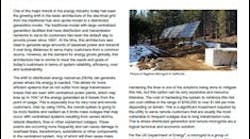Remote Microgrids as a Stepping Stone Towards Decarbonization
As demand for energy grows around the world, the electric grid’s architecture is evolving from the traditional hub-and-spoke model that’s been in place for nearly 140 years, into a more flexible, efficient, and sustainable distributed generation model. Remote microgrids are one of the key stepping stones towards decarbonization.
Microgrids powered by renewables like wind, solar, hyprdo, and geothermal energy generation can help utilities to meet their sustainability goals. Including fossil fuel driven generators ensure resiliency when the renewable generation can’t meet load requirements.
Customers in rural and remote areas can benefit from remote microgrids as they often see reduced energy costs and increased reliability. Remote microgrids can also businesses and utilities not only financially, but in reaching their sustainability goals.
In this paper, Generac describes how remote microgrids can help with the push towards global decarboniztion while also creating a more resilient energy system.
